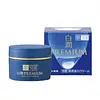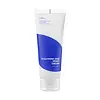What's inside
What's inside
 Key Ingredients
Key Ingredients

 Benefits
Benefits

 Concerns
Concerns

 Ingredients Side-by-side
Ingredients Side-by-side

Tranexamic Acid
AstringentCetyl Phosphate
EmulsifyingTocopherol
AntioxidantSodium Hyaluronate
HumectantHydrolyzed Hyaluronic Acid
HumectantSqualane
EmollientButyrospermum Parkii Butter
Skin ConditioningDipropylene Glycol
HumectantDiglycerin
HumectantLimnanthes Alba Seed Oil
Skin ConditioningDimethicone
EmollientGlyceryl Stearate
EmollientPEG-20 Sorbitan Isostearate
EmulsifyingPolyvinylalcohol Crosspolymer
EDTA
Hydroxyethylcellulose
Emulsion StabilisingSodium Metabisulfite
AntioxidantBehenyl Alcohol
EmollientStearyl Alcohol
EmollientPhenoxyethanol
PreservativeSodium Paraben
PreservativeTranexamic Acid, Cetyl Phosphate, Tocopherol, Sodium Hyaluronate, Hydrolyzed Hyaluronic Acid, Squalane, Butyrospermum Parkii Butter, Dipropylene Glycol, Diglycerin, Limnanthes Alba Seed Oil, Dimethicone, Glyceryl Stearate, PEG-20 Sorbitan Isostearate, Polyvinylalcohol Crosspolymer, EDTA, Hydroxyethylcellulose, Sodium Metabisulfite, Behenyl Alcohol, Stearyl Alcohol, Phenoxyethanol, Sodium Paraben
Water
Skin ConditioningGlycerin
HumectantHydrogenated Polydecene
EmollientCaprylic/Capric Triglyceride
MaskingDipropylene Glycol
HumectantCyclohexasiloxane
EmollientButyrospermum Parkii Butter
Skin ConditioningPolyglyceryl-3 Methylglucose Distearate
EmulsifyingCetyl Alcohol
EmollientGlycereth-26
HumectantGlyceryl Stearate
EmollientBetaine
HumectantBehenyl Alcohol
EmollientVinyldimethicone
Pentylene Glycol
Skin ConditioningLaminaria Japonica Extract
Skin ProtectingEclipta Prostrata Leaf Extract
Skin ConditioningAvena Sativa Kernel Extract
AbrasiveCynara Scolymus Leaf Extract
Skin ConditioningPrunus Armeniaca Kernel Oil
MaskingArgania Spinosa Kernel Oil
EmollientCarthamus Tinctorius Seed Oil
MaskingSodium Hyaluronate
HumectantHydrogenated Lecithin
EmulsifyingCamellia Sinensis Leaf Water
MaskingPolyglyceryl-10 Laurate
Skin ConditioningPentaerythrityl Distearate
EmulsifyingAmmonium Acryloyldimethyltaurate/Vp Copolymer
Glyceryl Caprylate
EmollientSodium Stearoyl Glutamate
CleansingMethylpropanediol
SolventFructooligosaccharides
HumectantDisodium EDTA
Beta-Glucan
Skin ConditioningHydrolyzed Hyaluronic Acid
HumectantPolyquaternium-51
Skin ConditioningButylene Glycol
HumectantHydroxypropyltrimonium Hyaluronate
Dimethylsilanol Hyaluronate
HumectantHydrolyzed Sodium Hyaluronate
Skin ConditioningPotassium Hyaluronate
Skin ConditioningHyaluronic Acid
HumectantSodium Hyaluronate Crosspolymer
HumectantSodium Acetylated Hyaluronate
HumectantSodium Hyaluronate Dimethylsilanol
Humectant1,2-Hexanediol
Skin ConditioningHydroxyacetophenone
AntioxidantEthylhexylglycerin
Skin ConditioningWater, Glycerin, Hydrogenated Polydecene, Caprylic/Capric Triglyceride, Dipropylene Glycol, Cyclohexasiloxane, Butyrospermum Parkii Butter, Polyglyceryl-3 Methylglucose Distearate, Cetyl Alcohol, Glycereth-26, Glyceryl Stearate, Betaine, Behenyl Alcohol, Vinyldimethicone, Pentylene Glycol, Laminaria Japonica Extract, Eclipta Prostrata Leaf Extract, Avena Sativa Kernel Extract, Cynara Scolymus Leaf Extract, Prunus Armeniaca Kernel Oil, Argania Spinosa Kernel Oil, Carthamus Tinctorius Seed Oil, Sodium Hyaluronate, Hydrogenated Lecithin, Camellia Sinensis Leaf Water, Polyglyceryl-10 Laurate, Pentaerythrityl Distearate, Ammonium Acryloyldimethyltaurate/Vp Copolymer, Glyceryl Caprylate, Sodium Stearoyl Glutamate, Methylpropanediol, Fructooligosaccharides, Disodium EDTA, Beta-Glucan, Hydrolyzed Hyaluronic Acid, Polyquaternium-51, Butylene Glycol, Hydroxypropyltrimonium Hyaluronate, Dimethylsilanol Hyaluronate, Hydrolyzed Sodium Hyaluronate, Potassium Hyaluronate, Hyaluronic Acid, Sodium Hyaluronate Crosspolymer, Sodium Acetylated Hyaluronate, Sodium Hyaluronate Dimethylsilanol, 1,2-Hexanediol, Hydroxyacetophenone, Ethylhexylglycerin
 Reviews
Reviews

Ingredients Explained
These ingredients are found in both products.
Ingredients higher up in an ingredient list are typically present in a larger amount.
Behenyl Alcohol is a type of fatty alcohol (these are different from the drying, solvent alcohols).
Fatty Alcohols have hydrating properties and are most often used as an emollient or to thicken a product. They are usually derived from natural fats and oils; behenyl alcohol is derived from the fats of vegetable oils.
Emollients help keep your skin soft and hydrated by creating a film that traps moisture in.
In 2000, Behenyl Alcohol was approved by the US as medicine to reduce the duration of cold sores.
Learn more about Behenyl AlcoholThis ingredient is also known as shea butter. It is an effective skin hydrator and emollient.
Emollients help soothe and soften your skin. It does this by creating a protective film on your skin. This barrier helps trap moisture and keeps your skin hydrated. Emollients may be effective at treating dry or itchy skin.
Shea butter is rich in antioxidants. Antioxidants help fight free-radicals, or molecules that may harm the body. It is also full of fatty acids including stearic acid and linoleic acid. These acids help replenish the skin and keep skin moisturized.
While Shea Butter has an SPF rating of about 3-4, it is not a sunscreen replacement.
Shea butter may not be fungal acne safe. We recommend speaking with a professional if you have any concerns.
Learn more about Butyrospermum Parkii ButterDipropylene Glycol is a synthetically created humectant, stabilizer, and solvent.
This ingredient helps:
Dipropylene glycol is technically an alcohol, but it belongs to the glycol family (often considered part of the ‘good’ alcohols). This means it is hydrating and gentle on skin unlike drying solvent alcohols like denatured alcohol.
As a masking agent, Dipropylene Glycol can be used to cover the smell of other ingredients. However, it does not have a scent.
Studies show Dipropylene Glycol is considered safe to use in skincare.
Learn more about Dipropylene GlycolGlyceryl Stearate is a mix of glycerin and stearic acid.
It is used to stabilize the mixing of water and oil ingredients. By preventing these ingredients from separating, it can help elongate shelf life. It can also help thicken the product's texture.
As an emollient, it helps soften skin and supports barrier-replenishing ingredients.
In cosmetics, Glyceryl Stearate is often made from vegetable oils or synthetically produced.
This ingredient may not be fungal-acne safe
Fun fact: The human body also creates Glyceryl Stearate naturally.
Learn more about Glyceryl StearateHydrolyzed Hyaluronic Acid is a form of hyaluronic acid. It is created by the hydrolysis of hyaluronic acid with a high molecular weight. Once created, Hydrolyzed Hyaluronic Acid has a low molecular weight.
Low molecular weight HA has been shown to hydrate and increase elasticity of the skin. Increasing elasticity is also associated with reduction of wrinkle depth.
One study found topical low molecular weight hyaluronic acid may be considered for the treatment of rosacea in the adult population. However, we always recommend speaking with a professional about your skin concerns.
Hyaluronic acids are a humectant. This means they draw moisture from the air. Hyaluronic acids help moisturize, soothe, and protect the skin.
Read more about other common forms of hyaluronic acid:
Learn more about Hydrolyzed Hyaluronic AcidSodium Hyaluronate is hyaluronic acid's salt form. It is commonly derived from the sodium salt of hyaluronic acid.
Like hyaluronic acid, it is great at holding water and acts as a humectant. This makes it a great skin hydrating ingredient.
Sodium Hyaluronate is naturally occurring in our bodies and is mostly found in eye fluid and joints.
These are some other common types of Hyaluronic Acid:
Learn more about Sodium Hyaluronate